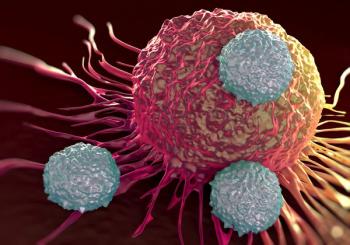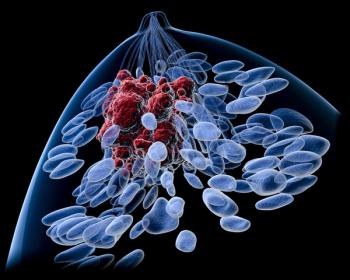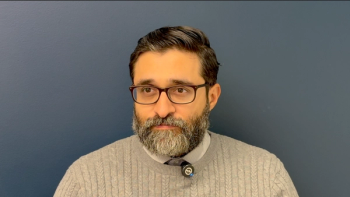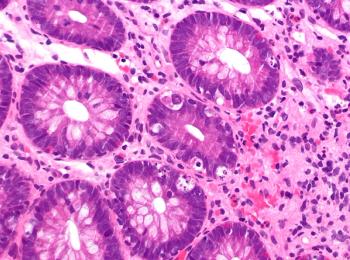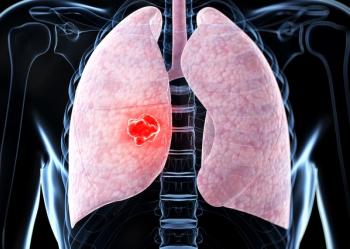
Cyclophosphamide-Based GVHD Prophylaxis May Improve Survival in HSCT
Many patients reported social/financial vulnerabilities that possibly precluded them from transplant access outside of the phase 2 clinical trial.
The addition of posttransplant cyclophosphamide (PTCy)–based graft-vs-host disease (GVHD) prophylaxis following allogeneic hematopoietic stem cell transplantation (HSCT) resulted in favorable 1-year overall survival (OS) outcomes in patients undergoing HSCT with human leukocyte antigen (HLA)–mismatched unrelated donors (MMUDs), according to findings from the phase 2 ACCESS trial (NCT04904588) published in the Journal of Clinical Oncology.1
Efficacy outcomes among 2 adult strata assessed in the study, myeloablative conditioning (MAC; n = 75) and reduced-intensity or nonmyeloablative conditioning (RIC/NMA; n = 70) before HSCT from a MMUD, revealed respective 1-year OS rates of 83.8% (95% CI, 73.1%-90.4%) and 78.6% (95% CI, 67.0%-86.5%). Additionally, the median follow-up for survival was 12.0 months (95% CI, 3.3-12.9) for MAC and 12.1 months (95% CI, 11.2-12.9) for RIC/NMA.
Additional data revealed that the rate of grade 2 to 4 acute GVHD at 6 months after HSCT were 30.7% (95% CI, 20.6%-41.3%) for MAC and 44.3% (95% CI, 32.4%-55.5%) for RIC/NMA; the respective grade 3 to 4 acute GVHD rates were 8% (95% CI, 3.2%-15.6%) and 10% (95% CI, 4.4%-18.4%). Furthermore, the respective 1-year National Institutes of Health moderate to severe chronic GVHD incidences were 10.3% (95% CI, 4.4%-18.9%) and 8.6% (95% CI, 3.5%-16.6%). Symptom burden among patients with moderate to severe chronic GVHD was significantly higher than in those with mild or no chronic GVHD (P < .01).
“This study is important because all patients, regardless of background, now have a stem cell or bone marrow transplant donor, a significant advance for our field, our patients, and our community,” Karen Ballen, MD, chief of hematology/oncology and medical director of stem cell transplant at the University of Virginia (UVA) Health, said in the news release on the publication of the phase 2 study.2 “At UVA Health, in the past year, all eligible patients for stem cell transplant were able to find a suitably matched donor.”
Between September 2021 and August 2023, 145 patients 18 years or older across 21 US-based centers were enrolled in the study. Those who received MAC were required to be younger than 66 years old and have a hematopoietic cell transplant-comorbidity index (HCT-CI) of less than 5. Patients with myelofibrosis and those with a suitable HLA-identical sibling or matched unrelated donor available were excluded.
Donors were required to have high-resolution HLA matching at 4 to 7 of 8 alleles, be considered eligible for donation, and be 18 to 35 years old. They were excluded from trial participation if they had donor-specific HLA antibody levels exceeding [a value of] 3000 mean fluorescence intensity against HLA-mismatched alleles. Donor searches were performed by the National Marrow Donor Program (NMDP) together with transplant centers.
Patients on the MAC stratum received fludarabine with busulfan or total body irradiation (TBI). Those on the RIC/NMA stratum received either fludarabine with busulfan, melphalan, or cyclophosphamide and low-dose TBI. The target CD34+ cell dose was 4 x 106 cells/kg, and grafts were given fresh or thawed following cryopreservation.
Patients in the MAC and RIC/NMA groups, respectively, had a median age of 46.1 years (range, 20.4-65.6) and 65.9 years (range, 24.3-77.9). Most patients were male (60.0% vs 50.0%), White (65.3% vs 72.9%), and not Hispanic or Latino (50.7% vs 75.7%).
Additionally, most patients had a Karnofsky performance score of 90 (57.3% vs 55.7%), a primary diagnosis of acute myeloid leukemia (44.0% vs 52.9%), and an adverse European LeukemiaNet risk category (57.6% vs 56.8%). In the MAC and RIC/NMA groups, 41.3% vs 42.9% of patients had an HCT-CI of 0 to 1 and 42.7% vs 40.0% had an HCT-CI of 2 to 3.
The median donor age in the respective groups was 24.8 years (range, 18.3-34.8) and 25.1 years (range, 18.7-35.3). Most donors were female (56.0% vs 55.7%), had double-positive cytomegalovirus status (33.3% vs 30.0%), and had HLA matching at 7 of 8 alleles (69.3% vs 67.1%).
The primary end point of the trial was OS after 1 year of HSCT. Secondary end points included cytokine release syndrome incidence after 14 days, cumulative 1-year relapse and nonrelapse mortality (NRM), hematopoietic recovery, 28-day primary graft failure (PGF), GVHD incidence, and patient quality of life.
The 1-year relapse rate in the MAC group was 22.9% (95% CI, 13.7%-33.5%) vs 21.4% (95% CI, 12.7%-31.7%) in the RIC/NMA group. The respective 1-year NRM rates were 10.8% (95% CI, 5%-19%) and 12.9% (95% CI, 6.3%-21.9%). PGF at 28 days was observed in 4 patients in the RIC/NMA stratum but not in the MAC stratum.
“Of note, many [patients] reported significant social and financial vulnerabilities that might have excluded them from transplant access outside the setting of a clinical trial. Beyond race and ethnicity, social vulnerability index scores indicate that MMUD HSCT improves access to curative therapy for socially vulnerable populations,” lead study author Monzr M. Al Malki, MD, professor in the Department of Hematology and Hematopoietic Cell Transplantation at City of Hope in Duarte, California, wrote in the publication with study coinvestigators.1 “Although future studies are necessary to optimize the safety and effectiveness of HLA-mismatched donor HSCT, the NMDP, transplant programs, and societies dedicated to health equity must work to develop interventions to address barriers to HSCT that extend beyond HLA.”
References
- Al Malki MM, Bo-Subait S, Logan B, et al. Post-transplant cyclophosphamide-based graft-versus-host disease prophylaxis after mismatched unrelated donor peripheral blood stem cell transplantation. J Clin Oncol. Published online June 16, 2025. doi:10.1200/JCO-25-00856
- ‘Mismatched’ transplants now safe for blood cancer patients. News release. University of Virginia Health. July 14, 2025. Accessed July 16, 2025. https://tinyurl.com/bs4p59cj
Newsletter
Stay up to date on recent advances in the multidisciplinary approach to cancer.


